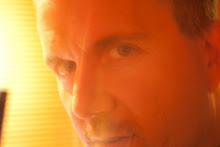 019 - I rarely leave my chair. Other than the occasional request to supervise a colour correction session or an audio mix there’s isn’t much call for me to actually use my legs. This can result, if left untreated, in a chronic case of “editor’s butt”. Trust me, it ain’t pretty. I really should get out more to see other people at work. Watching them work demonstrates individual methodology (the good and the bad) and provides insight into how I can improve my own day-to-day workflow. And isn’t that the underlying theme of my blogs?
019 - I rarely leave my chair. Other than the occasional request to supervise a colour correction session or an audio mix there’s isn’t much call for me to actually use my legs. This can result, if left untreated, in a chronic case of “editor’s butt”. Trust me, it ain’t pretty. I really should get out more to see other people at work. Watching them work demonstrates individual methodology (the good and the bad) and provides insight into how I can improve my own day-to-day workflow. And isn’t that the underlying theme of my blogs?On one occasion a spot I worked on was being re-composited at a 3D animation studio in (on?) a system I had never seen before. The interface was akin to tearing open an Avid timeline, letting the clips spill out, in a seemly in a random fashion, over a large gray table and having thin strings connect them together in some kind of order that escaped me. I thought it was a stupid interface.
But as I watched the animator work I noticed he always had access to my original media, his effected clips, and his trials and errors and his final composite -all in the same project and all in the same “space”. So when I went back to the shop I looked at my timeline in a very different way.
Let me back up for a moment. Have you ever worked on a Media 100 circa 1997 to 2001? If you have you know my pain. After working on an Avid for 5 years I was forced to use this system exclusively for four consecutive years (or was it decades, I can’t tell). Other than one single independent graphics layer it was strictly A-B roll editing. Some editors rock to this. But if you use an Avid (or Final Cut, or Premiere) I’m guessing you agree that while it is a very fast way to put together a cut it is a tragically inept way to keep up with the demands placed on post facilities. Adding layers upon layers of titles and graphics and tweak them with relative ease is a must today.
But there’s more to it than adding graphics . You might decide a single layer will only be your dialogue edit. The next layer only your b-roll. And more b-roll above that on the next. It can save a fair bit of trimming and sliding knowing your dialogue isn’t pushing or pulling everything else around the cut. It’s not appropriate for every project but when it is it is blindingly fast. So when we bought a brand new edit suite to work with in our brand new company, Avid it was (again). I swear to God I actually hugged the box the day I arrived.
But my experience with this animator and his system showed me that layers was offering me another amazing opportunity I never, ever considered- the ability to stack multiple versions of the same clips into the same timeline. Why on earth would I want to do this overly complicated thing? Well, since I frequently export material to be composited or colour corrected in After Effects, when it comes back it does so without any of the corresponding metadata that Avid needs to keep track of what it is and where it came from. And all the careful labeling in the world doesn’t allow me to see, in an instant, what I had done before.
So now, for my needs, the composited version of a clip is laid ON TOP of the original. And/or the colour corrected version of a clip is laid ON TOP of the original. When I hit Play all I see is the effected media but if I need to I can peek at the others. If I want to I can trim the original and export it for colour correction again. More importantly if I consolidate and backup this timeline the original rough-cut media and the final media are kept together. If a client needs changes I have everything I need to do them in one place. No messing with re-digitizing or re-importing. No sorting through older cuts to figure out what I did or backing up multiple timelines for safety.

Ten years ago this would have created a bloated media folder too large to handle, but today with cheap hard drive space a-plenty there’s really no reason not to. In short, I can have my cake and eat it too.

Very cool tip. Nice to re-read for the second time. As an aspiring editor I really enjoy reading your blog and have now read the whole thing so far, including the next post up (Optical Poetry).
ReplyDeleteI'm starting to get the hang of my Media Composer, after switching from Final Cut a year ago (slow learner? No. Life keeps getting in the way) but I instantly liked that the Avid coerced me into editing in a slightly more linear way. I suppose a good question to arrise from that is what do you think of Media Composer 5's new smart tool? Also a post on the art of how you edit and get a feel for a piece would be a fantastic insight.
Your Avid reader,
Stefan